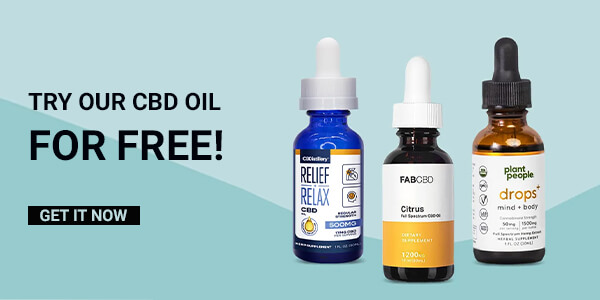Cannabidiol has gained popularity as a promising complementary remedy for different health issues, including epilepsy, anxiety, and pain management. Urits et al. (2019) confirmed the sentiments. CBD is one among the many cannabinoids that are found in cannabis and hemp plant.
There is a vast range of products like tinctures, balms, oils, and candy. All of these brands may help people experiencing physical pain. The cannabinoid is a term that refers to substances found within the plant. CBD and delta 9 tetrahydrocannabinol (THC) are two notable examples. THC is the compound responsible for the high that people associate with cannabis. CBD is another cannabinoid, and it does not make a person feel high.
This article will discuss how CBD products can help relieve pain. Provide a list of potentially effective CBD products that have been screened and undergone extensive third-party testing for safety.
Is CBD Oil Legal?
According to Abernethy (2019), marijuana was removed from the legal hemp in the 2018 Farm Bill in the controlled substance act. It is a hemp-made derived CBD product with less than 0.3% become THC federally legal. But CBD products that contain more than 0.3 % THC also fall under the legal definition of marijuana. It makes them federally illegal but legal under some state laws. Always check state laws, more so when traveling. The FDA has not approved nonprescription CBD products so some products may be inaccurately labeled.
Is CBD Oil Effective for Pain Management?
Cannabinoids are grouped into endogenous and exogenous. Endogenous cannabinoids occur naturally in lipids that are produced by the body. The two most known endogenous cannabinoids are anandamide and 2-arachidonoylglycerol. The human body does not produce exogenous cannabinoids. Such compounds are part of the cannabinoid plant. Examples are CBD, THC, Cannabigerol, and Cannabichromene Cannabinoids, both endogenous and exogenous, bind to endocannabinoid receptors attached to the cells. They include cannabinoids 1 and cannabinoid 2 receptors. The binding action stimulates various cell responses that influence pain signaling pathways.
Langford et al. (2018) evaluated CBD’s pain-relieving effects in seven people experiencing chronic pain after a kidney transplant. Six of them reported improvements in pain. One of them experienced a lot of pain at higher CBD doses but achieved the best pain control with lower doses of CBD.
As more research, such as large scale, and high-quality clinical trials, is still required, preliminary studies suggest that CBD may help manage pain. The previous research h also showed that participants in that research have a positive attitude to CBD treatment options and usually report positive outcomes when using it for pain-related conditions.
Using CBD Safely
CBD usually comes in oil and tinctures, oral capsules or pills, topical patches, creams, balms, gummies, and salves. CBD capsules and gummies are for oral ingestion. While on the other side, topical CBD products are only applied externally. Users can apply this specific body area like aching joints or sore muscles.
CBD oils and tinctures are more versatile than other forms and come in a tinted glass bottle with a dropper. You can either add some drops of CBD oil to food or beverages or even place a few drops under their tongue. They then hold the oil for up to one minute before swallowing. Individuals should always follow the directions and dosage information on the CBD information label.
Choosing the Right CBD Product
According to Rubin (2018), the Food and Drug Administration only regulates one CBD-containing drug known as Epidiolex. It is used to treat rare epilepsy in children of two years and above. It means that FDA does not regulate commercial CBD products. Users should look for high-quality products from manufacturers and retailers when shopping for CBD.
High-quality products must undergo third-party testing by laboratories without affiliation with the manufacturers. The products are usually tested for heavy metals, microbes, harmful chemicals, and pesticides. Products that undergo third-party testing undergo to have a certificate of analysis. It is a document that contains information about the product’s potency, THC presence, and other cannabinoid safety test results.
Risks and Side Effects
The side effects of CBD include changes in appetite, weight changes, diarrhea, and tiredness. More severe side effects are fertility problems in males, liver damage, and potential severe interactions with alcohol and certain medication.
CBD Products for Pain
CBD Cream for Muscle and Joint
Some CBD products provide a broad-spectrum CBD cream that contains either 500mg, 1000mg, or 3000 mg in each container. Rub (2022) gave a preview of the best products that can be used for muscle and joint pain. The cream is usually full of cannabinoids and contains caffeine and white willow bark, which helps to ease aches and pain. It also contains methanol for a cooling effect.
Hemp-infused Cooling Gel with CBD
This cooling gel contains full spectrum CBD menthol and arnica. The producer says this gel is free from several major allergens, synthetic fragrances, and parabens.
Massage Therapy Pain Relief Oil
The THC-free massage oil has methanol, camphor, and natural oil that can help relieve minor aches and pains. The study above confirmed the ability of CBD to ease the pain. The producer states that it is hypoallergenic and has undergone third-party testing. A single bottle of 103 milliliters contains about 200 mg of the hemp-extracted compound CBD.
Relief Lotion
This relief lotion contains CBD extract, arnica flowers, magnesium, shea butter, and essential oils. Kaplan et al. (2011) clarified that it helps relieve muscle pain, inflammation, and tightness when repairing and moisturizing the skin. A single bottle of relief lotion contains about 155.67 mg of CBD.
How quickly can it Provide Relief?
Like the underlying variables of health condition, CBD product, and dosage, many variables may affect how quickly CBD can provide pain relief. For instance, The American Arthritis Foundation suggests that a person can feel the effects of CBD spray or tincture in 15-45 minutes.
CBD Products Best for Pain Relief?
The best CBD product will depend on the condition, and an individual’s personal preference as the products are available in many forms, such as creams, oils, gels, and pitches. People can try which would work best for them. You can also choose to discuss options with your doctor.
Conclusion
As preliminary clinical studies and animal studies suggest CBD may help relieve pain, more research is still needed to evaluate these findings. CBD is safe, but it can lead to side effects, such as appetite changes and tiredness. Those currently receiving treatment for pain conditions can discuss the potential benefits and risks of adding CBD to their treatment plan with their doctor.
Reference
Abernethy, A. (2019). Hemp Production & 2018 Farm Bill. US Food And Drug Administration.
Kaplan, F. S., Shore, E. M., Glaser, D. L., & Emerson, S. (2011, May). The Medical Management Of Fibrodysplasia Ossificans Progressiva: Current Treatment Considerations. Clin Proc Intl Clin Consort FOP (Vol. 4, pp. 1-100).
Langford, R. M., Mares, J., Novotna, A., Vachova, M., Novakova, I., Notcutt, W., & Ratcliffe, S. (2013). A Double-Blind, Randomized, Placebo-Controlled, Parallel-Group Study Of THC/CBD Oromucosal Spray Combined With The Existing Treatment Regimen To Relieve Central Neuropathic Pain In Patients With Multiple Sclerosis. Journal Of Neurology, 260(4), 984-997
Rub, X. C. Best CBD Creams to Buy (2022) Top-Rated CBD Salves Balms That Work.
Rubin, R. (2018). The Path To The First FDA-Approved Cannabis-Derived Treatment And What Comes Next. Jama, 320(12), 1227-1229.
Urits, I., Borchart, M., Hasegawa, M., Kochanski, J., Orhurhu, V., & Viswanath, O. (2019). An Update Of Current Cannabis-Based Pharmaceuticals In Pain Medicine. Pain And Therapy, 8(1), 41-51.
Kristina Shafarenko is a relationship and health and wellness psychologist and a part-time freelance lifestyle writer covering health and fitness, sex, sexual wellness, and relationships. When she’s not writing, you can find her planning her next getaway, taste-testing every coffee spot in sight, and lounging at home with her cat, Buddy.
- Kratom Capsules By Just Kratom-Capsules of Kratom Bliss: Navigating My Journey with Just Kratom - October 2, 2023
- Introducing Cibadol Zero: One Of The First CBD Line Of Products That Contains Zero Thc - September 23, 2023
- Insider Scoop: What’S The Deal With Thc-Free CBD? - September 23, 2023








